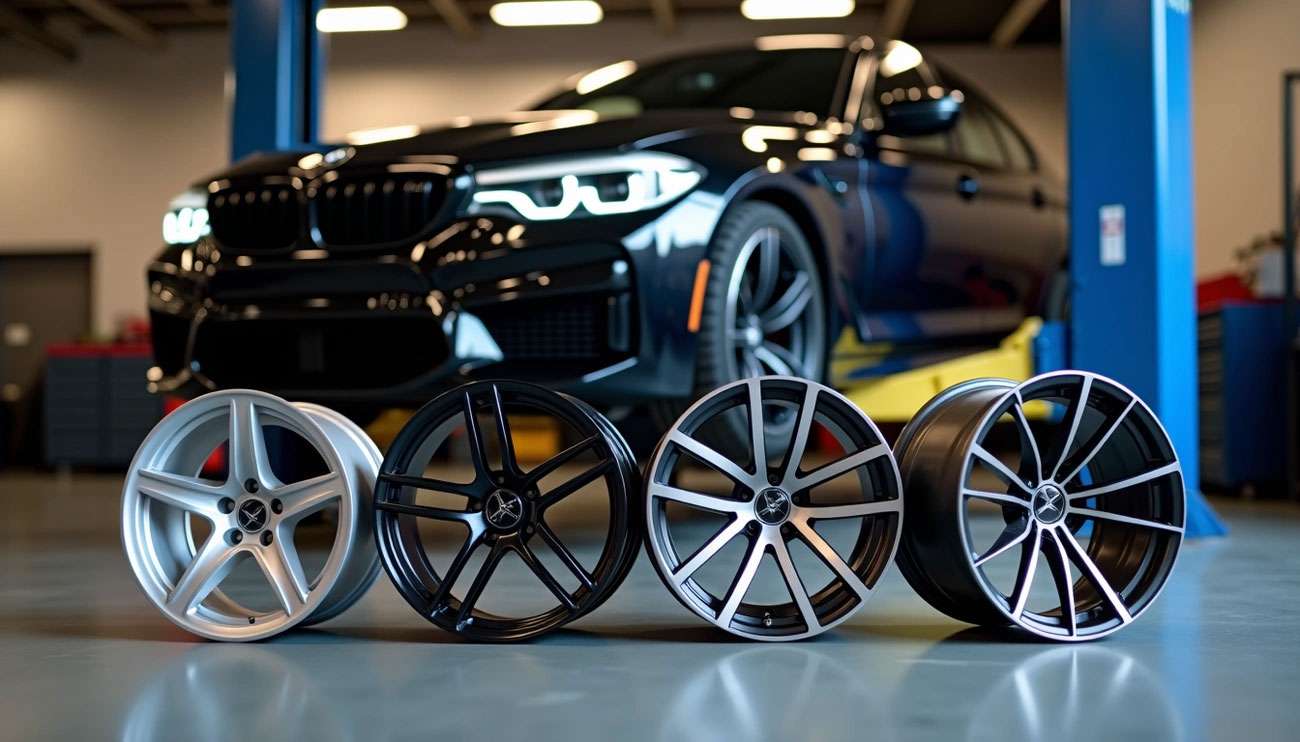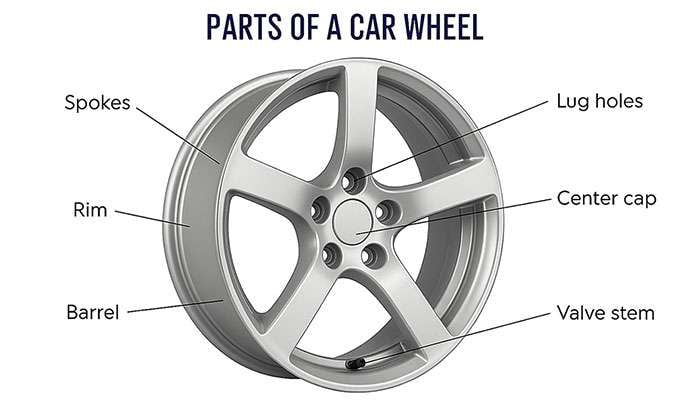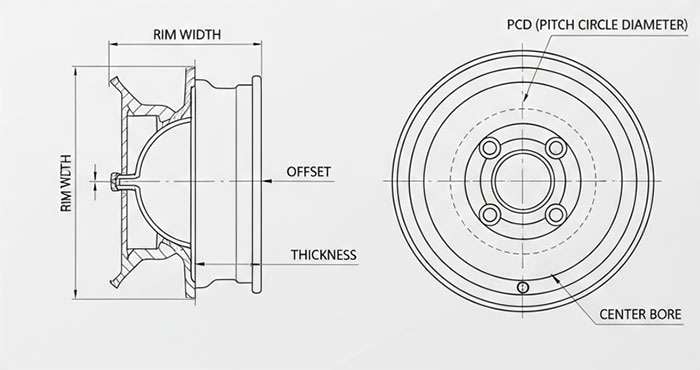
Did you know that currently, 17-inch-diameter wheels have the most wheel and tire options and will fit over most brake packages?
Selecting the right rims for your vehicle goes far beyond choosing something that catches your eye. Quality rims represent a substantial investment, and damaged rims create serious safety hazards on the road. The style and finish you choose can completely transform how your car or truck looks.
Understanding what to look for when buying car rims means considering both appearance and performance factors. Lighter wheels improve handling and reduce stress on your vehicle's suspension system. Poor backspace or offset choices can cause problems with body panels and steering components.
Whether you're trying to figure out how to choose rims for your car or what to check when buying used ones, this guide covers everything from basic terms to critical specifications. We'll help you make a smart decision that improves both how your vehicle looks and performs.

Understanding car rims starts with getting the fundamentals right. Many buyers mix up basic terminology, which leads to purchasing mistakes that affect both appearance and vehicle performance.
Rims and wheels are not the same thing, even though people often use these terms interchangeably. The rim is actually just one component of the wheel. The wheel is the entire metal assembly that includes the rim, hub, and sometimes spokes, while the rim is only the outer edge where the tire mounts. This distinction is important because the rim forms an airtight seal with the tire and supports the entire wheel assembly.
The rim's primary function is to support and seal the tire to the wheel, keeping air inside tubeless tires through proper fit. When you drive over a pothole, the rim takes the initial impact after it passes through the tire.
Your choice of rims impacts vehicle performance in several ways. The size, weight, and material of rims directly affect handling, braking, acceleration, and fuel economy.
Larger rims typically require low-profile tires with stiffer sidewalls. This combination can improve cornering and handling by reducing tire flex, but often results in a harsher ride because there's less tire cushioning. Smaller rims with higher-profile tires provide better comfort.
Weight matters significantly. Heavy rims increase "unsprung weight"—mass not supported by the suspension system. Higher unsprung weight hurts acceleration, braking efficiency, and fuel consumption. Lightweight alloy rims improve vehicle responsiveness and fuel economy.
Many people incorrectly use "rims" when talking about custom or stylish wheels, a habit that has spread through media and marketing. Another common confusion involves hubcaps, which are decorative covers that snap over the central part of some steel wheels and are not used on modern alloy wheels.
Some buyers think bigger always means better. However, oversized or heavy rims increase rolling resistance, which requires more fuel. Remember that rim diameter must match the tire's diameter—a 17" tire only fits a 17" rim.
Getting these basics right helps you make informed decisions instead of choosing based only on looks.

Understanding rim specifications is critical when selecting the right wheels for your vehicle. These technical details determine not only how your rims look but also how they perform with your car's specific requirements.
The diameter of a wheel is measured across the face from bead seat to bead seat (where the tire mounts), not the outer edge. Most wheels range from 13 to 24 inches in diameter, with 17-inch wheels offering the most options. A fundamental rule: you must match tire diameter to wheel diameter—a 16-inch tire fits only on a 16-inch wheel.
Width refers to the distance across the barrel of the wheel, also measured from bead seat to bead seat. Common wheel widths vary from 6 to 14 inches. This specification directly impacts your tire's contact patch with the road, affecting handling characteristics. Wider wheels provide better cornering stability but may require specific tire sizes to maintain proper fitment.
Offset and backspacing both describe wheel positioning relative to the mounting surface, yet measure it differently. Offset is the distance in millimeters from the wheel's mounting surface to its centerline. It can be positive (mounting surface toward outer edge), zero, or negative (mounting surface toward inner edge). Proper offset prevents wheels from rubbing against brakes, fenders, or suspension components.
Backspacing measures the distance from the mounting pad to the back lip of the wheel, typically in inches. To convert offset to backspacing for positive offset wheels: (Wheel Width + 1)/2 + (offset × 0.03937). For negative offset: (Wheel Width + 1)/2 – (offset × 0.03937).
The bolt pattern consists of two numbers—for example, 5×100 indicates five lug holes spaced around a 100mm diameter circle. Your wheel's bolt pattern must exactly match your vehicle's pattern for safe installation. Common patterns include 4, 5, 6, or 8 lugs.
The center bore is the machined opening at the back of the wheel that centers it on the vehicle's hub. This ensures the wheel is perfectly aligned with the axle, preventing vibration and ensuring even weight distribution.
Every wheel has a maximum load rating that should never be exceeded. This rating is determined by dividing your vehicle's heaviest gross axle weight by two. For instance, if your front axle is rated at 2,400 pounds, each front wheel must support at least 1,200 pounds.
Load ratings are typically stamped on the back of wheels, along with maximum PSI in some cases. Exceeding these limits can lead to catastrophic wheel failure, especially during impacts or emergency maneuvers. Since weight distribution is rarely perfect, always use the highest axle load as your reference point.
Selecting the perfect rims for your vehicle means matching style preferences with practical requirements. Smart buyers consider their specific driving needs before anything else.
Your vehicle's primary purpose should drive your rim selection. Performance driving calls for lightweight alloy wheels that deliver superior cornering precision, sharper steering response, and improved braking efficiency. Steel wheels work best for harsh conditions like snow or off-road terrain where durability matters most. Chrome finishes create stunning visual appeal but require regular maintenance to keep that mirror shine.
Proper rim width should complement your tire's tread width for optimal performance. "Plus sizing" increases wheel diameter while reducing tire sidewall height to maintain the same overall diameter. Online calculators help you visualize different wheel-tire combinations before you buy. Wider rims improve cornering stability but can reduce fuel efficiency and ride comfort.
Modern vehicles come equipped with Tire Pressure Monitoring Systems that need proper programming when you install new wheels. Check brake clearance carefully—larger brake systems require wheels with more inner barrel space. Poor clearance creates dangerous contact between wheels and brake components.
Used wheels require thorough inspection before purchase. Look for cracks around lug holes, bends, elongated bolt holes, and damaged weld lines. Test the wheel's balance and verify the bolt pattern matches your vehicle exactly. Even small hairline cracks can lead to catastrophic wheel failure down the road.
After researching and selecting suitable rim specifications, the final steps involve making smart purchasing decisions and ensuring proper installation.
Shopping for rims offers multiple options depending on your budget and preferences. Specialty retailers like Discount Tire carry extensive inventories from top wheel manufacturers, including Fuel Wheels, MB Wheels, Method Wheels, and many others. Buying used rims can save money, but requires careful inspection for wear, cracks, or deformities. For those seeking competitive pricing, Performance Plus Tire offers some of the lowest prices on car rims without compromising quality.
Online shopping has made rim purchases much easier through innovative tools. Most reputable retailers offer custom wheel visualizers that let you see wheels on your specific vehicle before buying. The safest approach starts by entering your vehicle's year, make, model, and trim level into fitment guides. This ensures compatibility and eliminates guesswork. Some sites even allow filtering by manufacturing type (cast, forged, flow-formed), color, bolt pattern, or brand.
Professional installation offers numerous advantages over DIY approaches. Professional installers have the technical knowledge to ensure proper installation while avoiding safety risks. Many manufacturers require professional installation to maintain warranty coverage. Professionals can properly reset your Tire Pressure Monitoring System (TPMS) after installation, along with correctly torquing lug nuts to manufacturer specifications.
Warranty offerings vary significantly between retailers. Premium options include lifetime structural warranties plus finish warranties ranging from 1-3 years. Most warranties exclude damage from misuse, accidents, or unauthorized modifications. While forged wheel orders are typically final and non-returnable, some retailers offer satisfaction guarantees for merchandise and apparel. Certain companies provide crash replacement programs at discounted rates even for accidental damage.
Selecting the right rims for your vehicle comes down to balancing technical requirements with your specific needs. We've covered the key differences between rims and wheels, cleared up common confusion, and shown how your rim choice affects more than just appearance.
Proper sizing is crucial for both safety and performance. Matching rim diameter with tire size, getting the offset and backspacing right, and confirming the correct bolt pattern prevents dangerous fitment problems. Never ignore load ratings when choosing new rims—exceeding these limits can cause wheel failure.
Your driving style should guide your rim selection. Performance drivers benefit from lightweight alloy options, while those tackling harsh conditions need durable steel wheels. Professional installation ensures proper torque settings, TPMS functionality, and warranty protection.
This guide gives you the knowledge to make smart rim-buying decisions. You can now balance style with technical needs while avoiding common mistakes. The right set of rims transforms your vehicle's appearance and improves its performance and safety on the road.
Understanding rim specifications and proper fitment is crucial for both safety and performance when upgrading your vehicle's wheels.
• Know the difference: Rims are just the outer edge where tires mount, while wheels include the entire assembly including hub and spokes.
• Match specifications exactly: Rim diameter must match tire diameter, and bolt patterns must align perfectly with your vehicle's requirements for safe installation.
• Consider your driving needs: Choose lightweight alloy rims for performance driving or durable steel rims for harsh conditions and off-road use.
• Inspect used rims thoroughly: Check for cracks, bends, and structural damage around lug holes, as even minor defects can lead to catastrophic failure.
• Professional installation matters: Proper torque specifications, TPMS programming, and warranty coverage require professional installation expertise.
The right rim choice balances esthetics with technical requirements, ensuring your investment enhances both your vehicle's appearance and road safety.
While often used interchangeably, rims are actually just one component of the wheel. The rim is the outer edge where the tire mounts, while the wheel includes the entire metal assembly with the rim, hub, and sometimes spokes.
Rim size and weight significantly impact vehicle dynamics. Larger rims can improve cornering and handling but may result in a harsher ride. Lighter rims reduce unsprung weight, improving acceleration, braking efficiency, and fuel economy.
Important specifications include diameter, width, offset, bolt pattern, and load rating. Ensure these match your vehicle's requirements and intended use. The rim's diameter must match your tire size, and the bolt pattern must align with your vehicle's specifications for safe installation.
Buying used rims can be cost-effective, but requires careful inspection. Check for cracks, bends, elongated bolt holes, and damaged weld lines. Even minor hairline cracks can lead to wheel failure, so thorough examination is crucial.
Professional installation ensures proper fitment, correct torque specifications, and proper reset of the Tire Pressure Monitoring System (TPMS). It also helps maintain warranty coverage, as many manufacturers require professional installation. Professionals can identify and address potential issues that might be overlooked in a DIY approach.